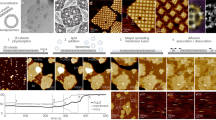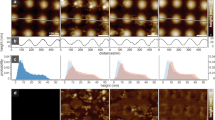Abstract
Membrane remodelling1,2,3,4,5 plays an important role in cellular tasks such as endocytosis, vesiculation and protein sorting, and in the biogenesis of organelles such as the endoplasmic reticulum or the Golgi apparatus. It is well established that the remodelling process is aided by specialized proteins that can sense4 as well as create6 membrane curvature, and trigger tubulation7,8,9 when added to synthetic liposomes. Because the energy needed for such large-scale changes in membrane geometry significantly exceeds the binding energy between individual proteins and between protein and membrane, cooperative action is essential. It has recently been suggested10,11 that curvature-mediated attractive interactions could aid cooperation and complement the effects of specific binding events on membrane remodelling. But it is difficult to experimentally isolate curvature-mediated interactions from direct attractions between proteins. Moreover, approximate theories predict repulsion between isotropically curving proteins12,13,14,15. Here we use coarse-grained membrane simulations to show that curvature-inducing model proteins adsorbed on lipid bilayer membranes can experience attractive interactions that arise purely as a result of membrane curvature. We find that once a minimal local bending is realized, the effect robustly drives protein cluster formation and subsequent transformation into vesicles with radii that correlate with the local curvature imprint. Owing to its universal nature, curvature-mediated attraction can operate even between proteins lacking any specific interactions, such as newly synthesized and still immature membrane proteins in the endoplasmic reticulum.
This is a preview of subscription content, access via your institution
Access options
Subscribe to this journal
Receive 51 print issues and online access
$199.00 per year
only $3.90 per issue
Buy this article
- Purchase on Springer Link
- Instant access to full article PDF
Prices may be subject to local taxes which are calculated during checkout




Similar content being viewed by others
References
Bannykh, S. I. & Balch, W. E. Membrane dynamics at the endoplasmic reticulum-Golgi interface. J. Cell Biol. 138, 1–4 (1997)
Lippincott-Schwartz, J., Roberts, T. H. & Hirschberg, K. Secretory protein trafficking and organelle dynamics in living cells. Annu. Rev. Cell Dev. Biol. 16, 557–589 (2000)
McMahon, H. T. & Gallop, J. L. Membrane curvature and mechanisms of dynamic cell membrane remodelling. Nature 438, 590–596 (2005)
Vogel, V. & Sheetz, M. Local force and geometry sensing regulate cell functions. Nature Rev. Mol. Cell Biol. 7, 265–275 (2006)
Voeltz, G. K., Prinz, W. A., Shibata, Y., Rist, J. M. & Rapoport, T. A. A class of membrane proteins shaping the tubular endoplasmic reticulum. Cell 124, 573–586 (2006)
Zimmerberg, J. & Kozlov, M. M. How proteins produce cellular membrane curvature. Nature Rev. Mol. Cell Biol. 7, 9–19 (2006)
Takei, K., Slepnev, V. I., Hauke, V. & De Camilli, P. Functional partnership between amphiphysin and dynamin in clathrin-mediated endocytosis. Nature Cell Biol. 1, 33–39 (1999)
Farsad, K. et al. Generation of high curvature membranes mediated by direct endophilin bilayer interactions. J. Cell Biol. 155, 193–200 (2001)
Itoh, T. et al. Dynamin and the actin cytoskeleton cooperatively regulate plasma membrane invagination by BAR and F-BAR proteins. Dev. Cell 9, 791–804 (2005)
Blood, P. D. & Voth, G. A. Direct observation of Bin/amphiphysin/Rvs (BAR) domain-induced membrane curvature by means of molecular dynamics simulations. Proc. Natl Acad. Sci. USA 103, 15068–15072 (2006)
Antonny, B. Membrane deformation by protein coats. Curr. Opin. Cell Biol. 18, 386–394 (2006)
Goulian, M., Bruinsma, R. & Pincus, P. Long-range forces in heterogeneous fluid membranes. Europhys. Lett. 22, 145–150 (1993)
Weikl, T. R., Kozlov, M. M. & Helfrich, W. Interaction of conical membrane inclusions: Effect of lateral tension. Phys. Rev. E 57, 6988–6995 (1998)
Bartolo, D. & Fournier, J.-B. Elastic interaction between “hard” or “soft” pointwise inclusions on biological membranes. Eur. Phys. J. E 11, 141–146 (2003)
Kim, K. S., Neu, J. & Oster, G. Curvature-mediated interactions between membrane proteins. Biophys. J. 75, 2274–2291 (1998)
Helfrich, W. Elastic properties of lipid bilayers — Theory and possible experiments. Z. Naturforsch. C 28, 693–703 (1973)
Zimmerberg, J. & McLaughlin, S. Membrane curvature: How BAR domains bend bilayers. Curr. Biol. 14, R250–R252 (2004)
Koltover, I., Rädler, J. O. & Safinya, C. R. Membrane mediated attraction and ordered aggregation of colloidal particles bound to giant phospholipid vesicles. Phys. Rev. Lett. 82, 1991–1994 (1999)
Chou, T., Kim, K. S. & Oster, G. Statistical thermodynamics of membrane bending-mediated protein-protein attractions. Biophys. J. 80, 1075–1087 (2001)
Fournier, J.-B., Dommersnes, P. G. & Galatola, P. Dynamin recruitment by clathrin coats: A physical step? C. R. Biol. 326, 467–476 (2003)
Cooke, I. R., Kremer, K. & Deserno, M. Tunable generic model for fluid bilayer membranes. Phys. Rev. E 72, 011506 (2005)
Müller, M., Katsov, K. & Schick, M. Biological and synthetic membranes: What can be learned from a coarse-grained description? Phys. Rep. 434, 113–176 (2006)
Venturoli, M., Sperotto, M. M., Kranenburg, M. & Smit, B. Mesoscopic models of biological membranes. Phys. Rep. 437, 1–54 (2006)
Brannigan, G., Lin, L. C.-L. & Brown, F. L. H. Implicit solvent simulations for biomembranes. Eur. Biophys. J. 35, 104–124 (2006)
Harmandaris, V. A. & Deserno, M. A novel method for measuring the bending rigidity of model lipid membranes by simulating tethers. J. Chem. Phys. 125, 204905 (2006)
Goulding, D. & Hansen, J.-P. Attraction between like-charged colloidal particles induced by a surface: A density functional analysis. Europhys. Lett. 46, 407–413 (1999)
Müller, M. M., Deserno, M. & Guven, J. Interface mediated interactions between particles — a geometrical approach. Phys. Rev. E 72, 061407 (2005)
Gottwein, E. et al. The Mason-Pfizer monkey virus PPPY and PSAP motifs both contribute to virus release. J. Virol. 77, 9474–9485 (2003)
Müller, M. M., Deserno, M. & Guven, J. Geometry of surface mediated interactions. Europhys. Lett. 69, 482–488 (2005)
Acknowledgements
We enjoyed discussions with I. R. Cooke, Ch. Peter, E.-K. Sinner, J. Guven, H.-G. Kräusslich and all members of the ESPResSo team at the MPI-P. B.J.R. acknowledges financial support from the collaborative research centre ‘From single molecules to nanoscopically structured materials’ and M.D. from an Emmy Noether fellowship, both of the Deutsche Forschungsgemeinschaft. A grant for computer time within the DEISA programme is also acknowledged.
Author information
Authors and Affiliations
Corresponding authors
Ethics declarations
Competing interests
Reprints and permissions information is available at www.nature.com/reprints. The authors declare no competing financial interests.
Supplementary information
Supplementary Information
This file contains Supplementary Methods, Supplementary Discussion, Supplementary Figure 1 illustrating the pair-correlation function of the small and large caps, Supplementary Table 1 presenting parameters of non-bonded interactions, Supplementary Videos Legends and additional references. (PDF 400 kb)
Supplementary Video 1
This file contains Supplementary Video 1 which shows vesiculation event driven by 36 large caps (see Figure 1) on a membrane containing 46 080 lipids. First, only membrane fluctuations and clustering of the caps are visible, then after 40 000 ζ a large protein aggregate buckles the membrane and the formation of a bud is observed. The movie length is 70 700 ζ ˜ 1 ms. (MOV 12408 kb)
Supplementary Video 2
This file contains Supplementary Video 2 which shows vesiculation event driven by 36 extra large caps on a membrane containing 46 080 lipids. The caps are constructed from two layers of 106 particles which is about twice the number as the large caps in Movie S1. Aggregation of the caps into small buds can be seen. At the end of the movie, the membrane is peeled away so that the buds can be clearly seen. The movie length is 16 700 ζ ˜ 0.25 ms. (MOV 9150 kb)
Supplementary Video 3
This file contains Supplementary Video 3 which shows cooperative budding driven by 16 capsids on a membrane containing 40 960 lipids. The formation of capsid pairs is seen, followed by the budding of clusters of 3 or 4 capsids. At the end of the movie the membrane is peeled away so that the buds can be clearly seen. The movie length is 39 800 ζ ˜ 0.6 ms. (MOV 24184 kb)
Rights and permissions
About this article
Cite this article
Reynwar, B., Illya, G., Harmandaris, V. et al. Aggregation and vesiculation of membrane proteins by curvature-mediated interactions. Nature 447, 461–464 (2007). https://doi.org/10.1038/nature05840
Received:
Accepted:
Issue Date:
DOI: https://doi.org/10.1038/nature05840
This article is cited by
-
Adhesion energy controls lipid binding-mediated endocytosis
Nature Communications (2024)
-
Enhancer–promoter contact formation requires RNAPII and antagonizes loop extrusion
Nature Genetics (2023)
-
MAxSIM: multi-angle-crossing structured illumination microscopy with height-controlled mirror for 3D topological mapping of live cells
Communications Biology (2023)
-
Mechanisms of BCL-2 family proteins in mitochondrial apoptosis
Nature Reviews Molecular Cell Biology (2023)
-
Insight into Biophysicochemical Principles of Biopolymers through Simulation and Theory
Chinese Journal of Polymer Science (2023)
Comments
By submitting a comment you agree to abide by our Terms and Community Guidelines. If you find something abusive or that does not comply with our terms or guidelines please flag it as inappropriate.



